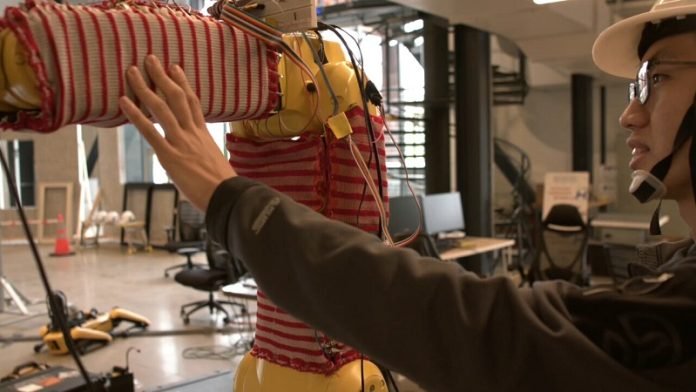
Imagine if your favorite cozy sweater could be the key to making robots better at interacting with people.
This is the idea behind a project from Carnegie Mellon University’s Robotics Institute.
They’ve made a special knitted “skin” for robots, called RobotSweater, that can sense when it’s being touched or pressed on.
Just like knitters can turn any kind of yarn into a sock, hat, or sweater of any shape or size, the RobotSweater fabric can be customized to fit over uneven, 3D shapes.
This is helpful because it means the fabric can be shaped to fit over even the most lumpy or curved robot surfaces.
This RobotSweater skin is not just for making robots more stylish. It serves a crucial purpose in an industrial setting, where robot-human interactions need to be safe.
With RobotSweater, robots can “feel” when a human touches them, and more importantly, they can detect any potential collisions, providing an extra layer of safety.
The secret of the RobotSweater lies in its fabric. It’s made of two layers of conductive yarn (yarn with metallic fibers that can carry electricity) and a layer of net-like, lace-patterned material sandwiched in between.
When someone touches the fabric, it completes an electrical circuit, and the sensors can read this.
The team behind RobotSweater faced a unique challenge: how to connect the soft textile with the wiring and electronics components.
They found a solution by wrapping the wires around snaps attached to the ends of each stripe in the fabric.
This method is even cost-effective and efficient enough for hobbyists creating e-textiles, or textiles with electronic elements.
Once fitted on the robot, RobotSweater can sense the distribution, shape, and force of any contact. It’s even more accurate and effective than the visual sensors that most robots currently use.
The robot can respond to human touches and gestures more effectively, like moving in the direction a human pushes it, or responding to social gestures.
The researchers have successfully demonstrated how RobotSweater can be used in real-life scenarios. For example, when fitted on a robot arm, RobotSweater could allow a human to guide the arm’s movement by simply pushing it, or command it to open or close its gripper by grabbing the arm.
Next, they want to explore how they can program the robot to react to the same touch motions we use on touchscreens, like swiping or pinching.
The team behind RobotSweater, which includes Ph.D. students and a visiting undergraduate student, will be presenting their research at a big conference on robotics.
The study has also been published on an online platform where scientists share their research before it’s officially published.



